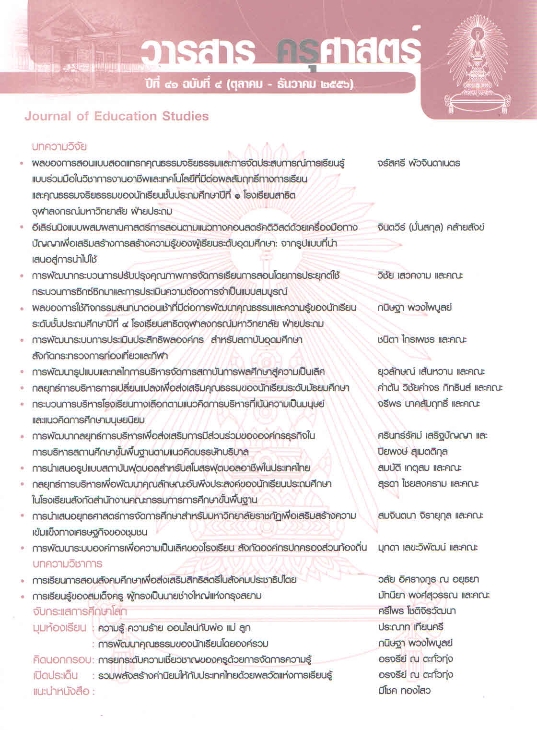การพัฒนาระบบองค์การเพื่อความเป็นเลิศของโรงเรียน สังกัดองค์กรปกครองส่วนท้องถิ่น
Abstract
การศึกษาครั้งนี้มีวัตถุประสงค์เพื่อพัฒนาระบบองค์การเพื่อความเป็นเลิศของโรงเรียน สังกัด องค์กรปกครองส่วนท้องถิ่น เก็บรวบรวมข้อมูลโดยใช้แบบสอบถามผู้บริหารองค์กรปกครองส่วนท้องถิ่น ผู้บริหาร ครู และกรรมการสถานศึกษา วิเคราะห์ข้อมูลโดยใช้ค่าเฉลี่ย ส่วนเบี่ยงเบนมาตรฐานและ โปรแกรม LISREL version ๘.๗๒ นำผลมาพัฒนาเป็นระบบองค์การ มีการตรวจสอบความเป็นไปได้ และความสอดคล้องของระบบโดยผู้ทรงคุณวุฒิ
ผลการวิจัยสรุปได้ดังนี้ ๑) ปัจจัยป้อน ได้แก่ ด้านภาวะผู้นำ ด้านบุคลากรครูและบุคลากรทาง การศึกษา ๒) กระบวนการแปรรูป ได้แก่ การนำนโยบายไปสู่การปฏิบัติ การใช้ทักษะการบริหารและ การปฏิบัติ การบริหารบุคคล งบประมาณและระบบบริหารขององค์การ การติดต่อสื่อสาร ระบบบริหาร การศึกษาของ อปท. การบริหารเชิงกลยุทธ์ การบูรณาการสาระในหลักสูตรก้าวไปสู่อาเซียน การใช้ เทคโนโลยีทางการศึกษา อาคารสถานที่ แหล่งเรียนรู้ภายใน การมีส่วนร่วมของชุมชน องค์กรเอกชน ศาสนา สถาบันทางการศึกษาอื่นๆ การมีส่วนร่วมในการระดมทรัพยากร ความร่วมมือของเครือข่ายความ ร่วมมือ ๓) ผลผลิต ได้แก่ ความพึงพอใจ คุณภาพการปฏิบัติงานของครู ความเจริญงอกงามและมีคุณธรรม จริยธรรม คิดเป็นและผลสัมฤทธิ์ทางการเรียนของนักเรียน
The objective of this study was to develop an organizational system to be used towards achieving an excellence of schools under the Local Administration Organizations. Data was gathered from schools administrators, teachers, and school board members through a questionnaire. Data was analyzed using arithmetic means, standard deviation, and Lisrel Program Version 8.72. A developed system was validated through using the judgment of experts.
Data showed that an organization system towards excellence of schools under the Local Administration Organizations. 1) Input: composed of leadership and personnel factors. 2) Process: composed of policy implementation competencies, managerial skills, personnel and budget administration, communication skills, change management, strategic management, curriculum integration towards the Asian Community, educational Technology utilization, learning resource utilization, and community participation including resource allocation capacity. 3) Output: composed of personnel satisfaction, teachers performances, personnel growth and virtue, students’ ethics and virtue, students’ thinking ability, and students’ achievement.




